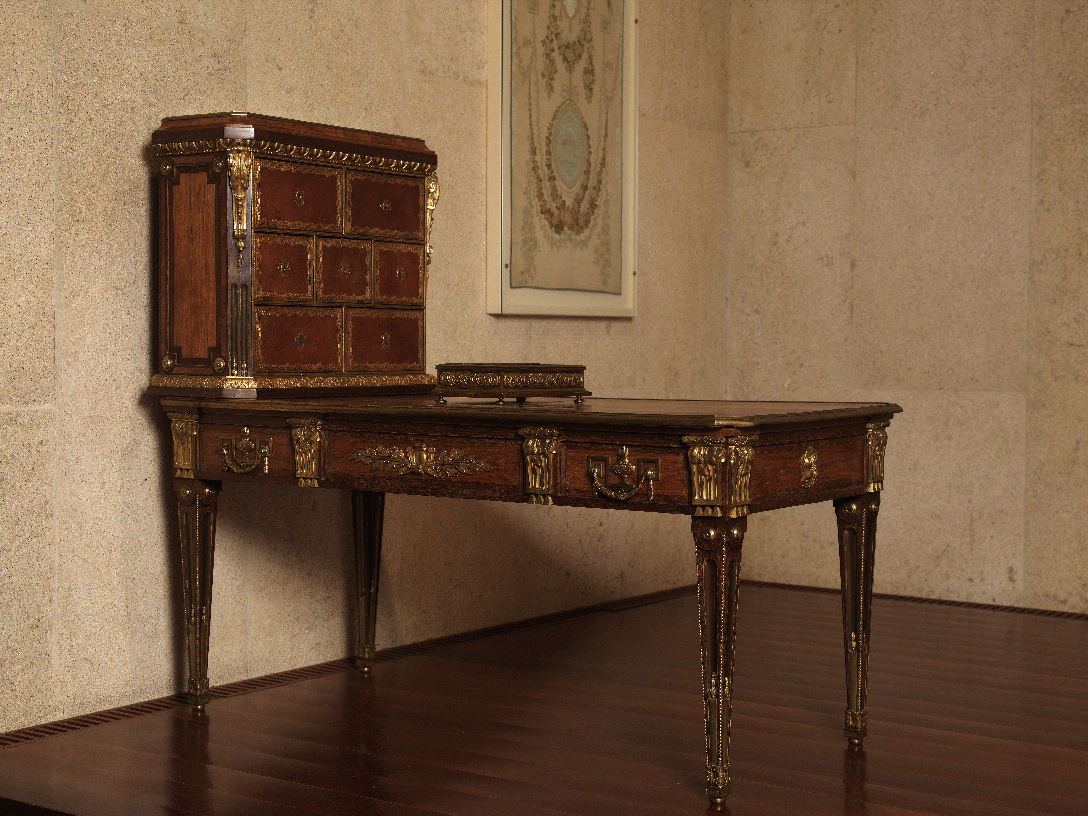
- Paris, c. 1762–5
- Carcass in oak and pine, inlaid with tulipwood and amaranthus; in the study the same woods are used, plus walnut; chased and gilded bronzes; copper; morocco
- Inv. 37
Writing desk, cabinet and inkstand
Pierre Garnier was a cabinetmaker who was noted not only for his technical and artistic skills but also for being one of the precursors of Neoclassicism.
This rectilinear desk, veneered with tulipwood and framed in amaranthus, features a rectangular top with cut-off corners.This top is covered in reddish-brown morocco leather framed by a double Greek frieze with daisies engraved in gold.The side is tripartite, with three drawers separated by a fluted motif forming a chased and gilded bronze console.The central drawer features a keyhole decorated with two intersecting oak leaves.The side drawers possess chased and gilded bronze urns framed by a single Greek frieze from which there hang wreaths and garlands of laurels, which stand out from the piece to serve as handles.The side surfaces of the writing desk are decorated with a single chased and gilded bronze rosette.The slender legs, which have a square cross-section, possess sharp corners emphasized by a line that is also in gilded bronze.The feet are embellished with plant motifs and end in a ball.
The rectilinear cabinet features seven compartments with handles that are lined with leather and finished off with a motif engraved in gold identical to that on the top of the writing desk.
The rectangular writing box is decorated around its rim by a frieze of interlinked rosettes. It is not known whether this piece was created for this group or for a similar one.
The writing desk, which displays architectural lines and a heavy silhouette, is in a contrasting style to much of the rocaille work that was being produced at the time.Garnier was an innovative cabinetmaker, and although at the start of his career he produced several pieces in the style of Louis XV, in the 1860s he definitively adopted Neo-classicism, using a Greek-style decorative grammar in his furniture which was very much to his taste, featuring wreathes, friezes, rosaces, urns, columns, capitals and fluting.
Marshal-Duke de Biron and descendants. Acquired by Calouste Gulbenkian through Graat & Madoulé at the sale of the collection of the Marquis de Biron, June 1914.
Writing desk: H. 77 cm; W. 162 cm; D. 80 cm
Bookcase: H. 68 cm; W. 80 cm; D. 31 cm
Study: H. 9 cm; W. 36 cm; D. 21 cm
Coutinho 1999
Isabel Pereira Coutinho, 18th-Century French Furniture. Lisbon: Calouste Gulbenkian Museum, 1999, pp. 191–7, no. 18.
Lisbon 2008
O Gosto 'à Grega'. Nascimento do Neoclassicismo em França, exhibition catalogue. Lisbon: Calouste Gulbenkian Museum, 2008, pp. 208–10, no. 32.
Lisbon 2011
Calouste Gulbenkian Museum. Lisbon: Calouste Gulbenkian Museum, 2011, p. 147, cat. 123.